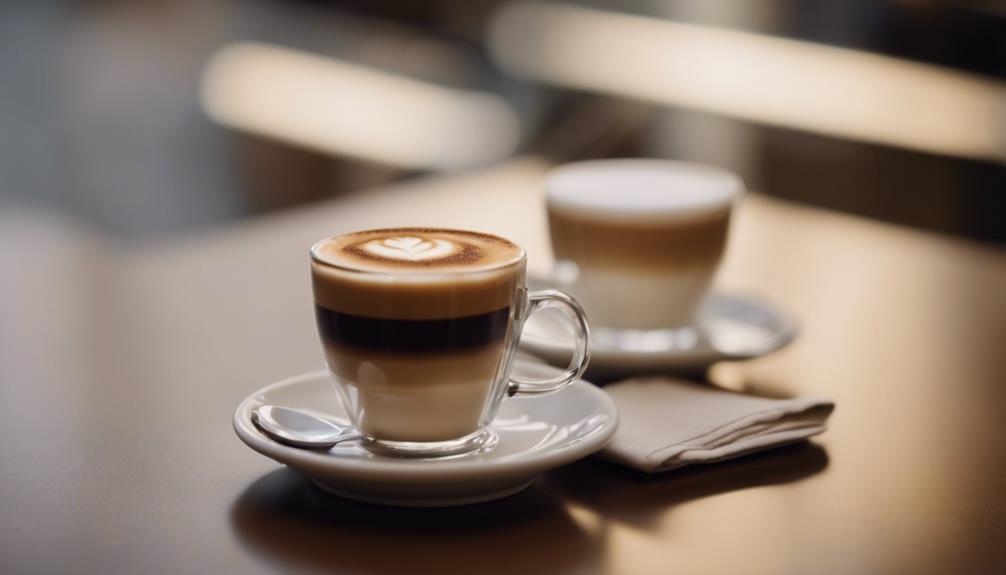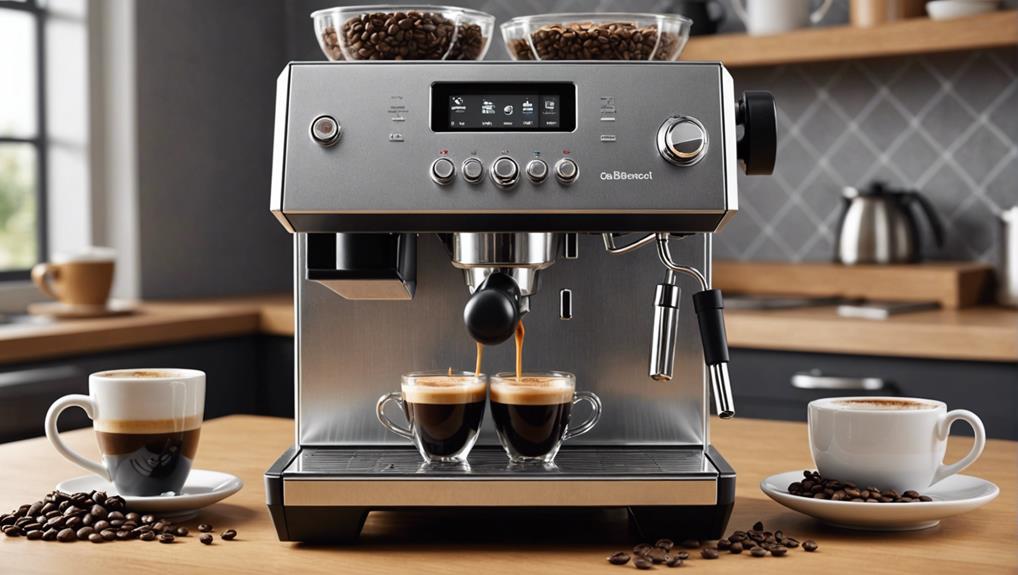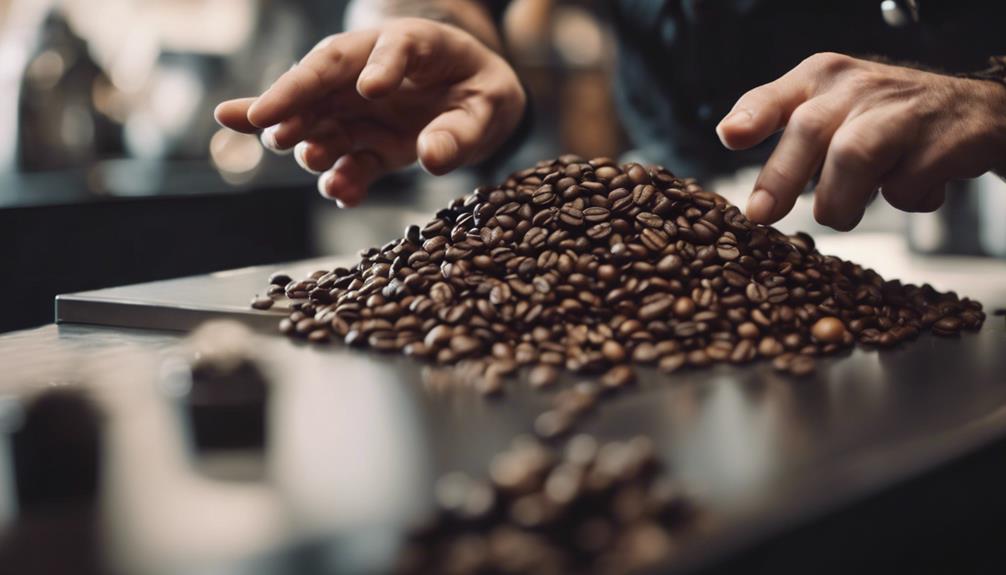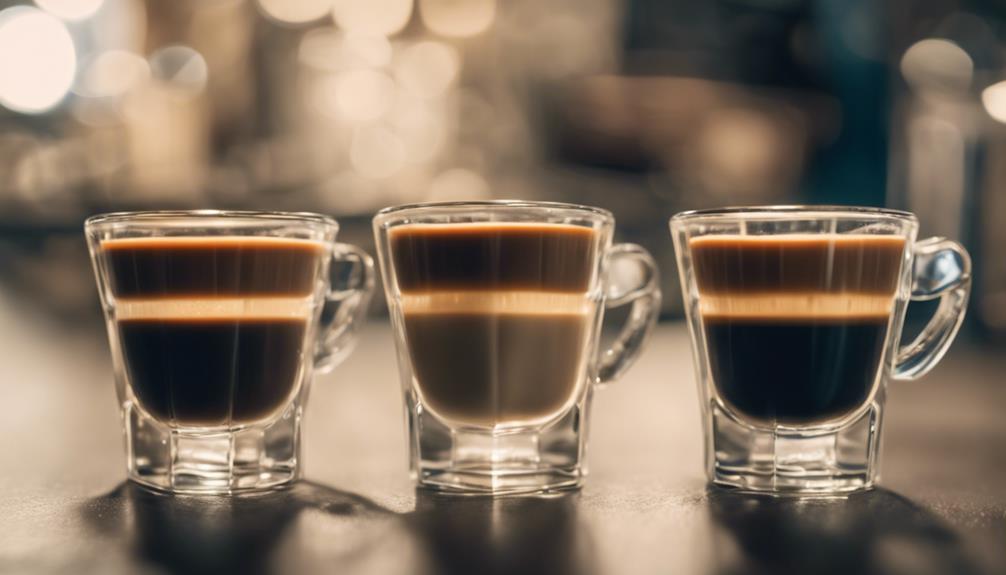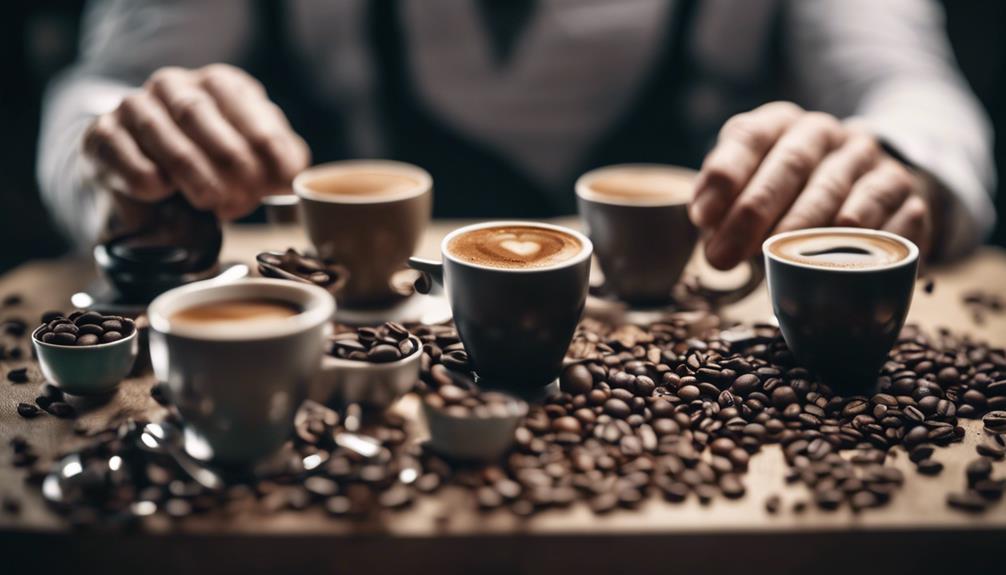In the coffee world, espresso and cappuccino are distinct in various ways. Espresso, which originated in Italy in the late 19th century, requires high pressure brewing to produce a strong, intense flavor in a small 1.5-ounce shot. On the other hand, cappuccino, named after Capuchin monks, combines espresso with steamed milk and foam to create a creamy, well-balanced taste in a larger cup. While espresso has a concentrated aroma with hints of caramel, cappuccino offers a smoother scent due to its milk components. Interested in these subtle differences? Keep exploring to gain a deeper understanding.
Key Takeaways
- Espresso is a concentrated shot of coffee, while cappuccino includes espresso, steamed milk, and foam.
- Espresso has a bold, intense flavor, whereas cappuccino offers a creamy and balanced taste.
- Espresso has a velvety, thick mouthfeel, while cappuccino has a smooth, creamy texture.
- Espresso is served in small 1.5-ounce shots, while cappuccino is served in larger cups.
- Espresso variations include classic shots, doppio, and ristretto, while cappuccino can be customized with flavored syrups and milk alternatives.
Origin and History
The origin and history of espresso and cappuccino trace back to Italy, where their distinctive characteristics were first developed. Espresso, created in the late 19th century, revolutionized coffee brewing with its rapid extraction method, producing a strong, concentrated shot of coffee that captured the essence of Italian coffee culture.
On the other hand, cappuccino, named after the Capuchin monks due to its color resembling the monks' robes, emerged as a harmonious blend of espresso, steamed milk, and velvety foam. Following the 1930s, cappuccino surged in popularity globally, becoming a staple in cafes worldwide alongside espresso.
The rich history of these beloved beverages not only showcases Italy's influence on the coffee industry but also highlights the craftsmanship and tradition that have made espresso and cappuccino enduring favorites for coffee enthusiasts worldwide. Understanding the roots of espresso and cappuccino adds depth to the enjoyment of these iconic drinks.
Brewing Method
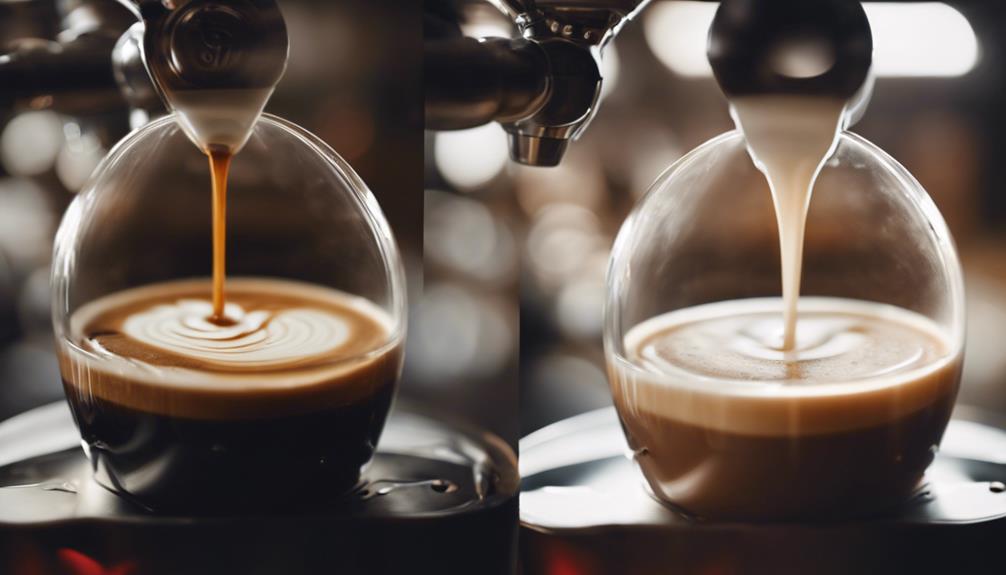
To brew espresso, pressurized hot water is forced through finely ground coffee beans, creating a concentrated and intense coffee shot. Espresso machines are essential for this process due to the high pressure needed to extract the flavors efficiently.
Here are three key points to keep in mind about the brewing method for espresso:
- Pressure is Vital: Espresso brewing requires a significant amount of pressure to push the water through the coffee grounds quickly, resulting in a strong and flavorful shot.
- Fine Grind Size: The coffee beans for espresso need to be ground finely to allow for efficient extraction during the short brewing time, ensuring a rich and robust flavor profile.
- Fast Extraction: Espresso is brewed rapidly, usually in about 25-30 seconds, to capture the intense flavors of the coffee beans without extracting any bitterness.
Flavor Profile
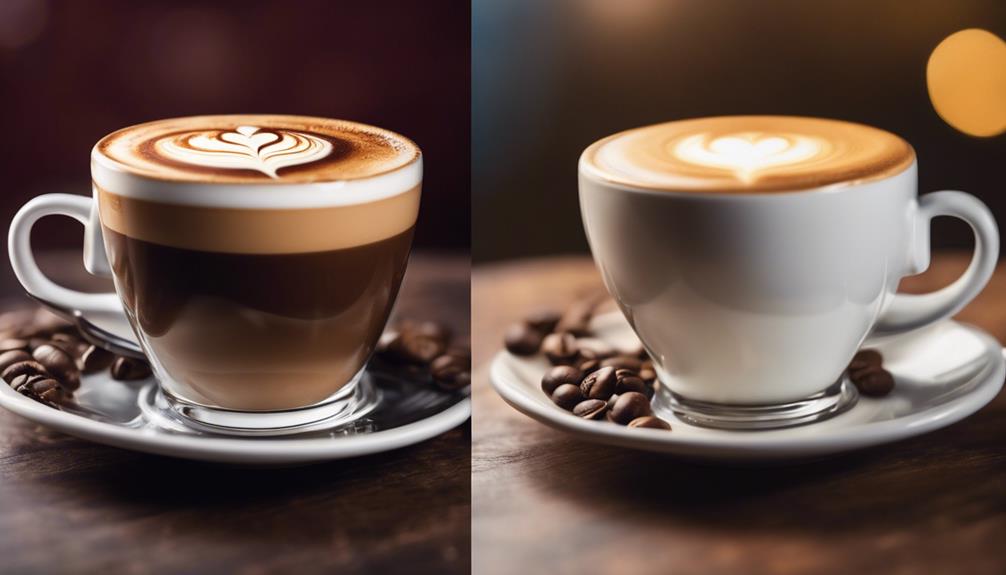
Espresso and cappuccino offer distinct flavor profiles. Espresso boasts a bold and intense taste, highlighting coffee bean nuances like caramel or chocolate.
In contrast, cappuccino presents creamy and balanced flavors, blending espresso, steamed milk, and foam for a smoother experience.
Espresso: Bold, Intense Taste
With its bold and intense flavor profile, espresso captivates coffee enthusiasts seeking a robust and complex taste experience. Here are three key points to help you understand why espresso stands out for its concentrated nature and rich flavor:
- Richness: Espresso is renowned for its bold flavor, packing a powerful punch in every sip. Its concentrated form allows the intricate flavors of the coffee beans to shine through, offering a robust and intense coffee experience.
- Complexity: The depth of espresso's taste comes from a combination of factors like the type of beans used, the level of roast, and the brewing technique. These elements work together to create a complex flavor profile that blends hints of bitterness and sweetness harmoniously.
- Extraction Process: The brewing process of espresso involves extracting the essence of the coffee beans under high pressure and heat, resulting in a strong and flavorful shot that showcases the true essence of the beans.
Cappuccino: Creamy, Balanced Flavors
Furthermore, Cappuccino presents a creamy and well-balanced flavor profile achieved through the harmonious combination of espresso, steamed milk, and milk foam.
The steamed milk in a cappuccino contributes a sweeter and smoother taste compared to espresso alone, enriching the overall flavor experience.
This drink's equal parts of espresso, steamed milk, and foam blend together to create a delightful mix of flavors that many coffee aficionados appreciate.
Additionally, the foam topping on a cappuccino not only adds a textural element but also enhances the visual appeal of the beverage, enhancing its overall flavor profile.
Besides, cappuccino's flavor can be further personalized by incorporating ingredients like cinnamon or caramel, providing a unique and customized taste experience.
The combination of espresso, steamed milk, and foam in a cappuccino results in a drink with a balanced and creamy flavor that delights the taste buds.
Aroma Differences Between Drinks
When comparing the aroma profiles of espresso and cappuccino, the distinct characteristics of each drink's flavor composition become evident. Here are some key differences to note:
- Espresso's Aroma:
Espresso is renowned for its bold and intense aroma, focusing on concentrated coffee flavors like caramel, chocolate, and nuts. The strong and invigorating scent appeals to those who appreciate the pure essence of coffee.
- Cappuccino's Aroma:
In contrast, cappuccino offers a smoother and more balanced aroma due to the addition of milk components and foam. The creamy sweetness of steamed milk combines with the robust espresso base, creating a softer and more inviting olfactory experience.
- Influence of Ingredients:
The aroma disparities between espresso and cappuccino arise from the varying ratios of coffee to milk and foam. Espresso emphasizes the pure coffee essence, while cappuccino's aroma is influenced by the added milk and foam textures, providing distinct aromatic experiences for coffee lovers.
Milk Content
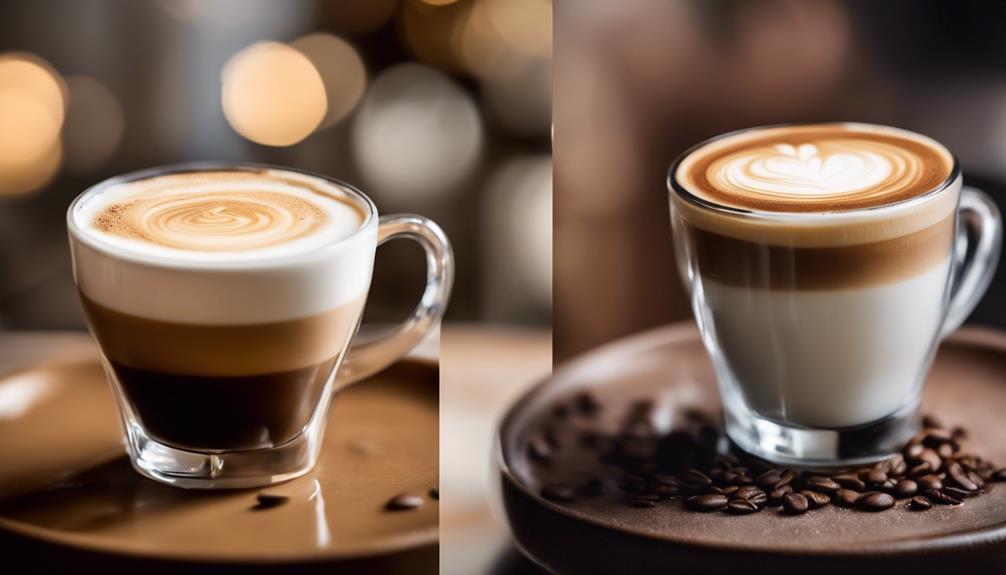
How does the milk content in these coffee beverages affect their flavor profiles?
When comparing espresso and cappuccino, the milk plays a significant role in shaping the taste experience.
Cappuccino consists of equal parts espresso, steamed milk, and milk foam, creating a creamy and well-balanced flavor profile. The addition of steamed milk provides a smoother texture and helps mellow out the intense flavors of espresso.
On the other hand, espresso is a pure shot of concentrated coffee without any added milk, resulting in a bold and robust flavor profile. The milk content in cappuccino offers a more subtle and rounded taste compared to the strong kick of espresso.
Additionally, the milk foam in cappuccino contributes to a velvety texture and enriches the overall drinking experience. The proportion of milk in cappuccino serves to balance out the potent flavors of espresso, providing a harmonious blend of coffee and dairy elements in each sip.
Texture and Consistency

Cappuccino's smooth and creamy texture comes from the velvety steamed milk and thick layer of foam, creating a delightful contrast in every sip.
In contrast, espresso boasts a thicker and more concentrated mouthfeel due to its high-pressure extraction process, resulting in a velvety and creamy sensation on the palate.
Understanding these differences in texture and consistency between espresso and cappuccino can enhance your appreciation of these popular coffee beverages.
Foam Vs. Crema
Creating a contrast in texture and consistency, the foam in cappuccino and the crema in espresso are distinctive elements that greatly influence the enjoyment of each beverage.
The foam in cappuccino is a thick layer of milk foam, achieved by steaming and aerating milk. On the other hand, the crema in espresso is a velvety, creamy texture formed by the interaction of coffee oils and solids during brewing.
Here are three key differences between foam and crema:
- Formation Process: Foam is created by steaming and aerating milk, while crema forms naturally during the espresso brewing process.
- Texture: Foam adds a creamy and smooth texture to cappuccino, enhancing its overall mouthfeel. Crema contributes to espresso's richness with its velvety consistency.
- Visual Appeal and Taste: Both foam in cappuccino and crema in espresso enhance the visual appeal of the drinks. Additionally, they play an essential role in the overall taste and experience, with foam providing a creamier texture in cappuccino and crema adding depth to the espresso's flavor.
Mouthfeel Comparison
The mouthfeel of espresso is distinctly velvety and thick, while cappuccino offers a smooth and creamy texture. Espresso achieves its creamy consistency through the high-pressure brewing process, resulting in a velvety richness that coats your palate. The crema, a golden-brown layer on top of espresso, enhances its texture and provides a depth of flavor.
On the other hand, cappuccino's texture is characterized by its smoothness and creaminess, attributed to the steamed milk and microfoam. The foam topping on a cappuccino adds a thick and airy layer, contributing to the overall mouthfeel experience. The combination of espresso, steamed milk, and foam in a cappuccino creates a well-balanced and satisfying texture that's both creamy and velvety.
Whether you prefer the thick and velvety richness of espresso or the smooth and creamy texture of a cappuccino, both coffee drinks offer a delightful mouthfeel that complements their distinct flavors.
Serving Size
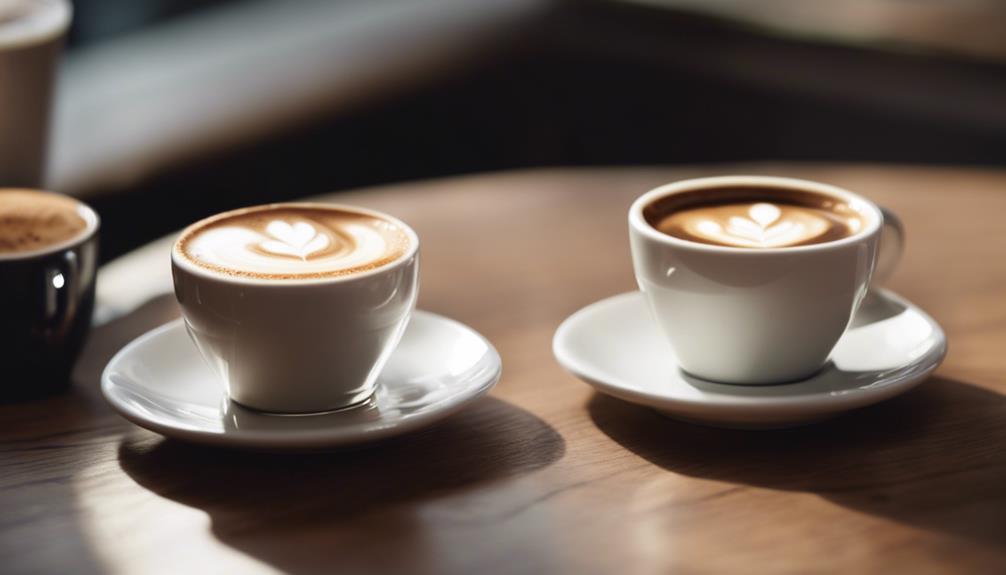
For a quick caffeine boost, espresso shots are typically served in small 1.5-ounce sizes. Here are the key differences in serving size between espresso shots and cappuccinos:
- Espresso Shot: The small 1.5-ounce serving size of an espresso shot delivers a concentrated flavor and high caffeine content, perfect for those who prefer a strong and quick coffee kick.
- Cappuccino: Cappuccinos are served in larger cups compared to espresso shots due to the addition of steamed milk and foam. The larger serving size provides a balanced and creamy coffee experience.
- Preference Variation: The difference in serving size between espresso shots and cappuccinos caters to varying preferences for coffee intensity and creaminess.
While espresso shots offer a bold flavor in a small serving, cappuccinos provide a more mellow and well-rounded coffee experience with the combination of espresso, steamed milk, and foam.
Popular Variations
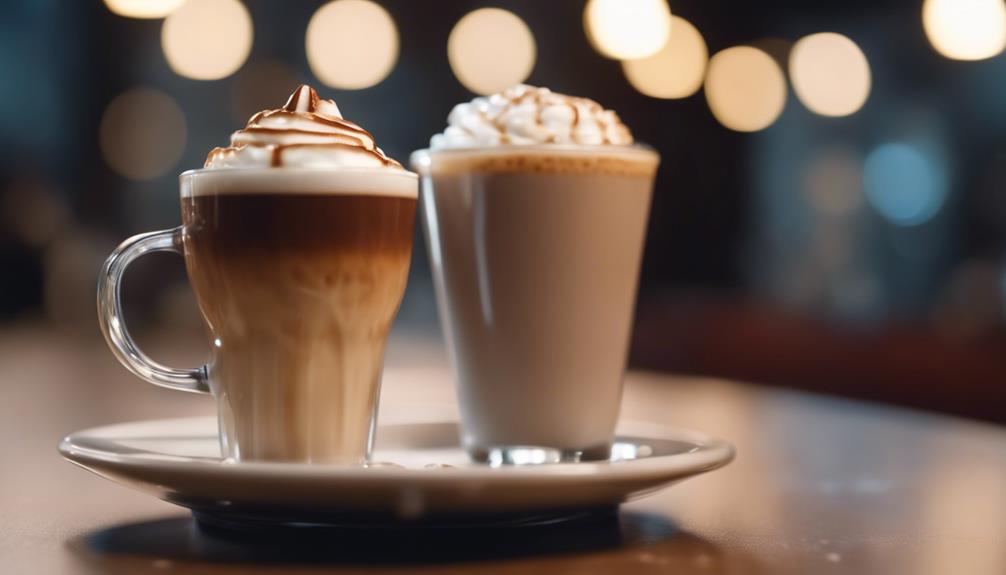
In addition to exploring the world of popular variations, delve into the diverse flavor options available for both espresso and cappuccino.
When it comes to espresso-based drinks, popular variations include the classic espresso shot and variations like the doppio, which offers a double shot for an extra caffeine boost. For those seeking a more intense flavor, the ristretto, a short shot of espresso, provides a concentrated taste experience.
On the other hand, cappuccino offers a range of flavored options such as vanilla, caramel, and hazelnut, adding a delightful twist to the traditional drink. Additionally, cappuccino variations may feature artistic designs on the foam layer, known as latte art, enhancing both the taste and visual appeal of the beverage.
Customization options like using almond, soy, or oat milk allow for catering to diverse dietary preferences and restrictions, making cappuccino a versatile and enjoyable choice for many coffee enthusiasts.
Frequently Asked Questions
What Is the Difference Between Cappuccino and Espresso?
The difference between cappuccino and espresso lies in their composition and flavor profiles. Cappuccino blends equal parts espresso, steamed milk, and milk foam, offering a sweet and creamy taste.
In contrast, espresso is a concentrated shot of coffee with a bold and intense flavor. While cappuccino has a higher caffeine content than regular coffee, espresso packs even more due to its concentrated nature.
Consider your preference for sweetness and intensity when choosing between these classic coffee options.
What Is the Main Difference Between Espresso and Coffee?
Espresso and coffee differ mainly in their brewing methods and strengths. Espresso is brewed by forcing pressurized water through finely ground coffee beans, resulting in a concentrated and intense flavor.
Coffee, on the other hand, is made by mixing roasted coffee beans with hot water, offering a less intense taste. Espresso contains about 5 times more caffeine per ounce than regular coffee, making it a potent energy booster.
What Makes a Cappuccino Different?
To distinguish a cappuccino, note its equal parts of espresso, steamed milk, and milk foam. This blend results in a creamy, well-balanced taste.
The name 'cappuccino' stems from Capuchin friars and has gained global popularity for its unique flavor and presentation. Particularly sweeter and creamier than espresso, cappuccinos offer a milder coffee experience.
With one-third espresso, one-third steamed milk, and one-third milk foam, cappuccinos deliver a harmonious mix of flavors and textures.
How Will You Differentiate Between Cappuccino and Latte?
To differentiate between a cappuccino and a latte, focus on the ratio of espresso to milk. A cappuccino has equal parts espresso, steamed milk, and foam, leading to a strong espresso flavor and a thick foam layer.
In contrast, a latte contains more steamed milk and less foam, resulting in a creamier texture and milder taste. Pay attention to cup size too; cappuccinos are served in smaller cups than lattes.
Conclusion
So now you know the key differences between espresso and cappuccino. Remember, the next time you're at a coffee shop, you can impress your friends with your newfound knowledge.
Just don't mix them up and order a cappuccino when you really wanted an espresso. That would be a bitter disappointment, both literally and figuratively.
Stay caffeinated and informed!
